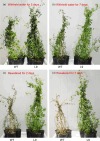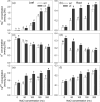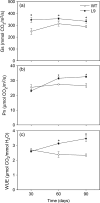Co-expression of tonoplast Cation/H(+) antiporter and H(+)-pyrophosphatase from xerophyte Zygophyllum xanthoxylum improves alfalfa plant growth under salinity, drought and field conditions
- PMID: 26268400
- PMCID: PMC11389104
- DOI: 10.1111/pbi.12451
Co-expression of tonoplast Cation/H(+) antiporter and H(+)-pyrophosphatase from xerophyte Zygophyllum xanthoxylum improves alfalfa plant growth under salinity, drought and field conditions
Abstract
Salinity and drought are major environmental factors limiting the growth and productivity of alfalfa worldwide as this economically important legume forage is sensitive to these kinds of abiotic stress. In this study, transgenic alfalfa lines expressing both tonoplast NXH and H(+)-PPase genes, ZxNHX and ZxVP1-1 from the xerophyte Zygophyllum xanthoxylum L., were produced via Agrobacterium tumefaciens-mediated transformation. Compared with wild-type (WT) plants, transgenic alfalfa plants co-expressing ZxNHX and ZxVP1-1 grew better with greater plant height and dry mass under normal or stress conditions (NaCl or water-deficit) in the greenhouse. The growth performance of transgenic alfalfa plants was associated with more Na(+), K(+) and Ca(2+) accumulation in leaves and roots, as a result of co-expression of ZxNHX and ZxVP1-1. Cation accumulation contributed to maintaining intracellular ions homoeostasis and osmoregulation of plants and thus conferred higher leaf relative water content and greater photosynthesis capacity in transgenic plants compared to WT when subjected to NaCl or water-deficit stress. Furthermore, the transgenic alfalfa co-expressing ZxNHX and ZxVP1-1 also grew faster than WT plants under field conditions, and most importantly, exhibited enhanced photosynthesis capacity by maintaining higher net photosynthetic rate, stomatal conductance, and water-use efficiency than WT plants. Our results indicate that co-expression of tonoplast NHX and H(+)-PPase genes from a xerophyte significantly improved the growth of alfalfa, and enhanced its tolerance to high salinity and drought. This study laid a solid basis for reclaiming and restoring saline and arid marginal lands as well as improving forage yield in northern China.
Keywords: H+-PPase; co-expression; stress tolerance; tonoplast NHXs; transgenic alfalfa.
© 2015 Society for Experimental Biology, Association of Applied Biologists and John Wiley & Sons Ltd.
Figures








References
-
- Andrés, Z. , Pérez‐Hormaeche, J. , Leidi, E.O. , Schlücking, K. , Steinhorst, L. , McLachlan, D.H. , Schumacher, K. , Hetherington, A.M. , Kudla, J. , Cubero, B. and Pardo, J.M. (2014) Control of vacuolar dynamics and regulation of stomatal aperture by tonoplast potassium uptake. Proc. Natl Acad. Sci. USA 111, 1806–1814. - PMC - PubMed
-
- Apse, M.P. , Aharon, G.S. , Snedden, W.A. and Blumwald, E. (1999) Salt tolerance conferred by overexpression of a vacuolar Na+/H+ antiport in Arabidopsis. Science, 285, 1256–1258. - PubMed
-
- Bao, A.K. , Wang, S.M. , Wu, G.Q. , Xi, J.J. , Zhang, J.L. and Wang, C.M. (2009a) Overexpression of the Arabidopsis H+‐PPase enhanced resistance to salt and drought stress in transgenic alfalfa (Medicago sativa L.). Plant Sci. 176, 232–240.
-
- Bao, A.K. , Guo, Z.G. , Zhang, H.F. and Wang, S.M. (2009b) A procedure for assessing the salt tolerance of lucerne (Medicago sativa L.) cultivar seedlings by combining agronomic and physiological indicators. N. Z. J. Agric. Res. 52, 435–442.
-
- Bao, A.K. , Wang, Y.W. , Xi, J.J. , Liu, C. , Zhang, J.L. and Wang, S.M. (2014) Co‐expression of xerophyte Zygophyllum xanthoxylum ZxNHX and ZxVP1‐1 enhances salt and drought tolerance in transgenic Lotus corniculatus L. by increasing cations accumulation. Funct. Plant Biol. 41, 203–214. - PubMed
Publication types
MeSH terms
Substances
LinkOut - more resources
Full Text Sources
Miscellaneous

